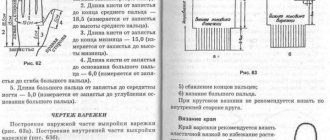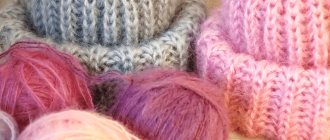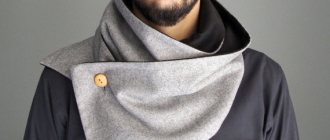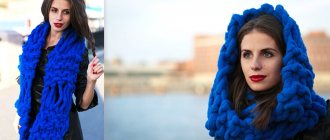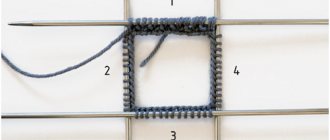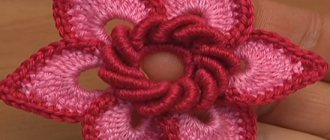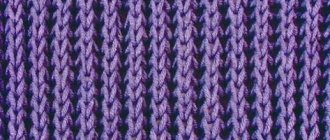Selection of yarn and knitting needles
Mohair is an unusual soft and fluffy thread. It consists of a base, which can have a different composition, and fluffy wool fibers. The wool is threaded onto the base in a special way without strong twisting. This determines the fluffiness of the thread and its properties. Mohair is one of the warmest threads. It is used to create warm and cozy winter clothes, in particular sweaters.
An important feature of this yarn is its lightness and airiness. Mohair consumption is always small. A garment made from this yarn will be light and airy. There are several varieties of mohair in composition and thread thickness. They are presented in the table.
Table
| Compound | Footage | |
| Synthetic mohair | 50-70% acrylic; 50-30% wool | 500 m per 100 g yarn |
| Mohair on a natural basis | 50-70% silk; 50-30% wool | 500 m per 100 g yarn |
| Kid mohair on a synthetic base | 50-70% acrylic; 50-30% wool | 250 m in 25 g yarn |
| Kid mohair on a natural basis | 50-70% silk; 50-30% wool | 250 m in 25 g yarn |
Kid mohair is a very thin thread, but you need to choose fairly thick knitting needles, at least 3.5. Products made from this yarn are weightless and translucent. At the same time very warm. This thread can be used for satin stitch or openwork knitting.
Regular mohair can be complemented with lurex thread or sequins. This yarn should be used for elegant sweaters that are suitable for special occasions. Mohair is usually knitted with needles size 4-5 or larger.
The choice of knitting needles depends on the idea, the knitting pattern and the characteristics of knitting. If the craftswoman knits tightly, then it is worth choosing a larger number of knitting needles so that the thread lies freely and reveals all its properties in the fabric.
Mohair is suitable for sweaters:
- knitted with satin stitch;
- elastic band (regular or bulky);
- openwork pattern.
The amount of yarn should be chosen based on the description of the specific model and size of the product. For a regular satin stitch sweater size 44-46, 200-300 g of mohair may be enough.
The different composition of mohair determines its cost. Mohair or kid mohair on acrylic will cost about 200 rubles. for 100 gram skein. Silk thread will cost 2 or 3 times more. According to tactile sensations, the composition of the thread base is not decisive. Mohair will always be very soft. Kid mohair is considered a more delicate thread.
Women's sweater knitted from mohair yarn according to the pattern with description
Of all the possible yarns used for knitting, mohair yarn is perhaps the warmest. Moreover, it is also the lightest thread. The quality of mohair is very high. The material is thin and very delicate, and the items knitted from it are stunningly beautiful. In addition, mohair sweaters can protect you from the cold in winter and from the heat in summer. All this gives mohair a huge advantage over other types of yarn. That is why the heroine of this article will be a knitted sweater made of mohair.
General preparation tips
Mohair sweaters are a very useful item in the wardrobe. But before you start knitting, it's better to learn a few tips. After choosing a model, you will need to purchase yarn. Mohair can be naturally white, beige, gray or brown. But on the shelves of handicraft stores you can find all sorts of colors and shades obtained artificially. When purchasing yarn, pay attention to the information that is usually indicated on the packaging. The quality of a knitted sweater will entirely depend on how correctly you choose the tool. If you use knitting needles whose volume exceeds 2 or even 4 times the thickness of the yarn, the fabric will have an openwork appearance. But if your instruments are thin, then mohair sweaters will have greater density. Choose a motif and practice it to understand how the thread is laid, what tension to choose, and then get to work.
Beautiful jacket with a wrap
Mohair is a very delicate material, but at the same time warm. And if you knit a beautiful sweater from it, it will quickly become your favorite wardrobe item.
You can knit a mohair blouse according to the suggested description. Or you can also use a pattern or replace the pattern of the top shelf with any other one.
Patterns for mohair products
To make a mohair sweater, you can use simple but effective openwork motifs. For example, “Shamrock” or “Light Openwork”.
The simple shamrock pattern is very easy to remember. At the same time, you will get a very beautiful openwork, light and airy. Mohair threads will help a lot with this:
The front (front part) is knitted according to the pattern. The wrong side of the knitting is done according to how the pattern goes. The elements outlined in a rectangle at 5 and 11P are intercepted with thread. To do this, insert the knitting needle between 7 and 8 P, pull the thread through and knit it with the adjacent loop at the same time. We continue according to the diagram.
In the “light openwork” there are no complex transitions at all, so it is accessible even to inexperienced knitters:
Such patterns will make your mohair sweaters airy and graceful. And the process of knitting will bring a lot of pleasure.
Video: Patterns for mohair products
Patterns and descriptions of knitting mohair sweaters
Mohair sweatshirts size 42-44
We will work with knitting needles No. 4,7,9 and ninth circular in two threads. Yarn – a mixture of mohair (70%) and acrylic (30%). The patterns we will use are “Knitted Satin” and “English Rib”:
Let's start knitting the back. We cast on loops (P) in the amount of 59 pieces (tool No. 7) and work with the “Front stitch” motif. As we go, we remove 1 P from the right and left every 9 rows (P). We perform this procedure three times. As a result, 53 P remain on the instrument. We continue until we get a length of 28 cm. And from this moment we begin in every eighth row on both edges 1 P. We also repeat 3 times. Now the number of elements is again equal to 59. We begin to create the armholes of the sweater when the height reaches 46 cm. To complete them, you should close 3 P on the right and left and three times 1 P through each 1P. There should be 47 elements left. Having knitted 18 cm from the beginning of the armhole, we proceed to forming the neckline. To do this, we close the central 17 P. To round the neck, on the sides on the side that is located inside, we remove 2 and 1 P twice through each P. Having reached a length of 66 cm, we bevel the shoulders. For this purpose, we close 5 P on each half twice through the row. At this point the back is ready. The length should be 68 cm.
The next stage is knitting the front of the sweater. Let's start with the right part. On the same knitting needles we cast on 4P. We knit in stockinette stitch, adding on the right, where there will be a fastener through 1 P, 1 P three times, 2 P - 7 times and 1 P - 4 times. Having reached a length of 42 cm, we create a neck. In every fourth row, after knitting the edge element, we remove 1 P. This must be done 9 times. Having knitted up to 46 cm, we create an armhole. First, close 3 P, and then after 1 P, 1 P three times. We make the bevel of the shoulder similarly to that on the back, when the height is 66 cm. We knit the left front symmetrically:
Let's start with the sleeves. Now we will use knitting needles number 9. Set - 39 P. We will alternate motifs on the sleeve fabric: 11 cm we knit with an elastic band, and 3 cm with a satin stitch (knitting tools of the fourth number). We alternate until we get 59 cm of the product, after which we knit it using only an elastic band. In order for the sleeve to become rounded, we remove it through a row of 1 x 2P, 7 x 1P, 1 x 2P. There are 11P left that just need to be closed. The length of such a sleeve will be 70 cm. The second part is made in a similar way.
All that remains is to collect everything that was imposed into one whole. First we sew the sleeves. We connect the back with the shelves, sewing along the lines of the shoulders and on the sides, and sew in the sleeves. Now you can knit a wide border along the entire edge of the sweater. We take circular ninth knitting needles, raise the elements, of which there should be 252 and, using the “English elastic” pattern, we make a strip 18 cm wide. Close the loops and cut the thread.
Video: Knitting a mohair jumper
vnitkah.ru
Mohair ribbed sweater
A knitted mohair sweater, the patterns and description of which are given below, is suitable for every day for young or adult women.
This model is knitted from 4 parts:
- back;
- front end;
- 2 sleeves.
After assembling all the parts, you need to lift the loops along the neckline and knit the collar on circular knitting needles. To knit this sweater, it is better to use regular mohair with a yardage of 500 m per 100 g. If you knit from kid mohair, it is better to work in 3-4 plies of thread so that the pattern holds its shape.
The main pattern used in this work is English elastic. It looks impressive and voluminous in the finished product. This is a double-sided elastic band that resembles a regular 1 by 1 elastic band, but it is voluminous and more impressive. Usually requires more yarn, which makes the sweater heavier. But if you knit from mohair, the thread consumption is very small and the item will turn out to be light.
You need to knit an English rib according to the following pattern:
- You can knit on an even or odd number of stitches. Loops can be cast on in any convenient and familiar way.
- The 1st row is the basic one, it is knitted in a special way: 1 edge loop, 1 knit stitch, purl the next loop along with the yarn over. Repeat this until the end of the row, until the last 2 stitches. Knit the penultimate one, and purl the edge one (if there is an even number of loops). If there is an odd number of stitches in the work, then finish the row with a purl, double crochet and one edge stitch.
- The second row is knitted like this: 1 edge stitch, then a purl loop follows the pattern, remove it purlwise with a double crochet, then a knitted loop follows the pattern, knit these 2 loops with a regular knit stitch. Repeat until the end, purl the last stitch of the row, like an edge stitch. If there is an even number of loops in the work, then there will be a front loop before the edge loop.
- Knit all subsequent rows according to the description of the second row.
A sweater knitted from mohair according to the patterns and descriptions for this model will turn out dense if you choose thin knitting needles for work.
If you choose a tool of a larger number, the canvas will be looser and lighter. It all depends on desire and taste. Before starting work, you need to calculate the knitting density to determine the number of loops.
To do this, it is important to knit a small sample using an English elastic band using the selected thread and selected knitting needles. You can cast on 25-30 stitches and knit about 20 rows. Then you need to draw a pattern for the future sweater, indicate your measurements and calculate the number of loops based on the knitted sample.
Since mohair is a very soft and thin thread, the pattern for such a sweater can be very simple: 2 rectangles for the back and front with a cutout for the neckline and two rectangles for the sleeves with a slight extension to the armpits.
Knit a sweater like this:
- It's better to start with the back part. Cast on the required number of loops, based on the calculation, and knit to the desired length without changing the selected pattern. For the neckline, bind off the middle third of all cast-on stitches and finish the shoulders separately, knitting another 4-6 rows.
Knitted mohair sweater. Knitting patterns
Knitted mohair sweater. Sleeve knitting patterns
- Then knit the front part in the same way, but start closing the neck a little earlier, dividing the number of loops for the neck into 4 parts. First, close the middle loops of the neck, then close the remaining loops along the edges of the neck in several parts.
- Knit sleeves symmetrically. Cast on the required number of loops and knit upwards, evenly adding 1 loop every 10 cm on both sides.
Sew all the details, first sew the shoulder seams, then sew the sleeves, then sew the side seams. Raise the loops along the neckline on circular knitting needles and knit the collar to the desired length.
The sweater is ready. This is a simple basic model that always looks trendy and will suit any style of clothing. You can change the length and width of the product to your taste, change the cut of the sleeves and armholes, and design the neckline in different ways.
The neck can be:
- stand (knit on circular knitting needles to the desired length);
- clamp;
- V-neck;
- round neckline;
- boat.
Decorating the neck of a sweater with a cord
Neckline can be decorated in different ways:
- noose;
- simple binding with stockinette stitch, then it will round off stylishly;
- tied with an elastic band.
This universal model is very easy to implement and gives room for creativity.
Mohair knitting patterns
After the yarn has been purchased and you have decided what you want to knit, it’s time to choose a pattern for the item. How to choose the most beautiful and suitable pattern from the whole variety? Below are some simple patterns and patterns that are a little more complex. However, they are all very beautiful and fit perfectly with mohair knitting. All you have to do is choose which one you like best.
Option one. Mohair leaves
- The number of loops is collected, the number of which is divided by 10, and do not forget about the edge ones.
- 1st row - nac., 2nd row. persons left, 8 faces.
- Row 2 and all even rows - all stitches are knitted according to the pattern.
- 3rd row - knits., nak., 2 together. persons left, knit 5, knit 2 persons to the right, nak.
- Row 5 - knit 2, nac, knit 2. persons left, knit 3, knit 2 persons right, right, knits.
- Row 7 - knit 5, nac, knit 2. persons to the left., 3 faces.
- Row 9 - knit 3, knit 2. persons to the right, yarn over, knits., yarn over, 2 together. persons left, knit 2.
- 11th row - knit 2, knit 2. persons to the right, nak., 3 knits., nak., 2 together. persons left, knits.
- Row 13 is identical to row 1.
Option two. Mohair diamonds
- To work, select the number of loops, the number of which is divided by 12, and do not forget about the edge loops.
- 1 row - 2 together. persons right, yarn over, knit 2, purl, knit, purl, knit 2, knit, 3 ins. persons., nac.
- Row 2 and all even rows - all stitches are knitted according to the pattern.
- 3rd row - knit, purl, knit, nak, 2 ins. persons left, knits., 2 mixed. persons right, right, knits., purl, knits., purl.
- Row 5 - knit, purl, 2 mixed. persons left, nak., 3 knits., nak., 2 mixed. persons right, purl, knits, purl.
- Row 7 - knit, purl, knit 2, knit, 3 ins. knits., nak., 2 knits., purl., knits., purl.
- 9 row - knit., nak., 2 knit. persons right, knits., purl., knits., purl., knits., 2 mixed. persons left, nak., knits., nak.
- Row 11 - knit 2, nac, knit 2. persons right, purl, knits, purl, 2 inc. persons left, nac., purl., 2 faces.
- Row 13 is identical to row 1.
Option three. Waves
- To work, select the number of loops, the number of which is divided by 13, and do not forget about the edge loops.
- 1st row - knit., nak., 4 knit., 3 knit. knits., 4 knits., nak., knits.
- Row 2 and all even rows - all stitches are knitted according to the pattern.
- Row 3 - knit 2, knit, knit 3, knit 3. knits., 3 knits., nak., 2 knits.
- 5 row - knit., nak., 2 knit. persons left, nak., 2 knits., 3 mixed. knits., 2 knits., nak., 2 mixed. persons right, right, knits.
- Row 7 - knit 2, nac, knit 2. persons left, nak., knits., 3 together. knits., knits., nak., 2 combined. persons right, right, knits.
- 9 row - knit., nak., 2 knit. persons left, nac., 2 inc. persons left, nac., 3 inc. knits., nak., 2 mixed. persons to the right, nak., 2 inc. persons right, right, knits.
- Row 11 - all stitches are knitted inside out.
- Row 13 is identical to row 1.
Option four. Simple openwork
Despite its simplicity, the pattern turns out very beautiful! It is enough to knit a test sample to make sure of this.
- To work, select a number of loops, the number of which is divisible by 9, and do not forget about the edge loops.
- 1st row - knit., nak., 2 knit., 3 knit. knits., 2 knits., nak., knits.
- Row 2 and all even rows - all stitches are knitted inside out.
- Row 3 - knit 2, knit, knit, 3 knit. knits., nak., 2 knits.
- Row 5 - knit 3, nac, knit 3. knits., nak., 3 knits.
- Row 7 - identical to row 1.
With the shoulder down
The knitted mohair sweater, diagrams and descriptions of which follow below, has a very striking feature - a dropped shoulder. This model can be worn during the day for everyday activities and even in the evening for a special occasion.
This feminine and seductive sweater, made of mohair, will complement a delicate look with trousers or a skirt. If you knit longer parts of the back and front, it can become a tunic or dress.
This sweater looks very stylish and impressive. Even a novice craftswoman can knit it, since the knitting here is the simplest. It is knitted from the same parts of the back and front, sleeves and collar.
For work, it is better to use mohair of any shade. You can take a thread with lurex or sequins. For a denser product, you can knit in 2 threads. Knitting needles for this model need regular straight ones or on fishing line No. 4.5-6.
You need to start working from the back:
- On 4.5 knitting needles you need to cast on 75 loops and knit with a regular 2 by 2 elastic band about 7-8 cm (or any desired height).
- Switch to stockinette stitch and change needles to number 6. Evenly in the 1st row of stockinette stitch, add 10 stitches.
- Then work in a straight line to the required height.
- Switch to knitting needles No. 4.5 and knit 2 by 2 rib again to the desired height (approximately 7 cm). Close the loops.
- Tie the front in the same way. You should get 2 identical parts.
- Then knit the sleeves. Cast on 50 stitches on knitting needles No. 4.5 and knit a 2 by 2 rib stitch. Add 10 stitches and knit in stockinette stitch to the desired height. In this case, in every 10th row you need to add 1 loop from each edge. Knit 2 parts.
Now you need to sew the parts. You need to start stitching from the shoulders. To do this, sew 24 front and back loops on each edge. Then sew in the sleeves and sew the side seams. You can make a seam using a needle with a wide eye or a crochet hook from the wrong side in half-columns.
How to knit a mohair jumper with knitting needles
Many fashionistas, when selecting new items for their wardrobe, repeatedly settle on such a product as a jumper.
Because its variability in combination with other things allows you to create a different image each time: romantic or businesslike. And in combination with the bright color of the jumper itself, you can even afford to go to a party. However, such a product is not always budget-friendly, and sometimes you have to pay a large sum for a good, high-quality item. Nevertheless, you can even knit such a jumper yourself! The price will be much cheaper, and the result will delight you for more than one season. After all, as you know, handmade work is especially valued. Moreover, a hand-knitted item will certainly not leave anyone indifferent, and with proper care it will last quite a long time!
For experienced needlewomen, knitting a jumper from mohair or any other yarn will not be difficult. And novice craftswomen can knit a fairly simple model that will not only look beautiful in the finished version, but also not highlight errors in the work too clearly.
Important! During the work process, you need to maintain the original knitting density.
Knitting a mohair jumper with your own hands
Mohair is a very interesting material, which usually also contains acrylic, viscose or silk. These additives give mohair yarn durability and wear resistance.
Depending on your skill level and experience in knitting, you can choose knitting needles or a crochet hook. Using these materials you can knit a beautiful product, but you should remember that the patterns with knitting needles will differ from those made with a crochet hook. With a strong desire and active imagination, you can combine knitting methods in one product.
In general, crocheted products will be more airy and light. Openwork patterns and light stitches are perfect for knitting such a jumper. This item will be very weightless and warm enough to wear in the cold season.
Jumpers knitted with knitting needles are usually denser in texture and much warmer, since the “breathability” of such a thing is much less.
Model selection
Most often, jumpers made from mohair yarn are knitted with a loose fit to the figure. Mohair items do not increase it too much, so they are suitable for women of any size. Of course, there are some nuances with which you can emphasize both the advantages and disadvantages of the products. Therefore, it is important to remember that:
- for women with curvy arms, it is better to use a simple pattern for knitting sleeves;
- A decorative belt will help highlight the figure of the owner of a wasp waist.
There are plenty of options for knitting mohair jumpers. Products with the simplest possible patterns are often popular, but combinations of several patterns are very interesting.
For example:
- the combination of a classic stockinette stitch on the back and front will look great in addition to an openwork pattern on the sleeves;
- the “leaves” pattern can be the main one throughout the entire canvas, or in fragments;
- sleeves or the entire product can be knitted with a “honeycomb” pattern - this is an alternation of front and back loops through one;
- a jumper flared over the body with tapered sleeves will look quite interesting in combination with tight-fitting clothes (model Galina);
- a fitted item goes better with wide sleeves.l
In general, finding “your” pattern is quite easy. And during the knitting process, you can interestingly combine transitions between patterns.
Attention! It should be remembered that before starting work you must knit the sample. This will not only allow you to make the calculations correctly, but will also facilitate learning how to knit a pattern.
Oversized sweater
A knitted mohair sweater, the diagrams and description for which are given below, looks very stylish and modern. It will suit any look and any figure. It is very easy to knit; even a beginner can do it.
To work you need to prepare:
- Mohair from any company, 500 m per 100 g - 400 g.
- Knitting needles number 5.
It is better to knit it in regular satin stitch, adding a 2 x 2 elastic band. For the model, you can use any openwork pattern or combination of patterns. If desired, you can knit braids or cones on the main fabric or sleeves.
The oversized sweater pattern is as simple as possible. These are 2 large rectangles for the back and front with a V-neck in the front and 2 sleeve details with an extension from the elastic to the armpits.
Step by step knitting:
- Work should begin with the back part. To do this, you need to knit a rectangle using stockinette stitch or any chosen pattern.
- Then knit the front part in the same way as the back, but, not reaching 15-20 cm from the top of the part, divide the work into 2 equal parts and form a neckline.
- You need to divide all the loops into 3 parts. The central loops are the neck loops and the side parts are the shoulder loops.
- You need to form the neckline by decreasing 1 stitch in each front row from the neckline until only the shoulder stitches remain in the work. Finish the shoulders separately to the desired height.
Such a neckline does not need to be processed in any way; the model assumes some carelessness and the free edge of the neckline will correspond to the style.
- Knit 2 identical sleeve parts. To do this, cast on loops and knit a 2 by 2 elastic band to the desired height.
- Go to the satin stitch or selected pattern. Knit to a height of 40-50 cm, evenly adding 1 stitch on each side every 10 rows.
- Then sew all the details. If you knit a sweater of sufficient length, you can wear it with a wide belt, like a tunic.
You can decorate this oversized model with patch pockets or use yarn of several shades, forming contrasting stripes.
With raglan sleeve
A mohair sweater with knitting needles, patterns and descriptions for which are discussed below, is knitted in one piece at the top and has a raglan sleeve.
This method of knitting is loved by many, since there is no need to sew the parts together after work and you can immediately see the finished product, which can be tried on while working. To create this model you need knitting needles on a fishing line of the required number and mohair. First, as usual, the sample is knitted, the knitting density and the number of loops to cast on are calculated.
When knitting from mohair, you can use the simplest knitting - satin stitch from facial loops , since the thread itself will decorate the product. And if you choose mohair with lurex or sequins, then the patterns will be superfluous.
Work starts from the neck:
- You need to cast on the required number of loops on circular knitting needles and close the work in a circle. Knit 5-7 cm with an elastic band 2 by 2 or 1 by 1, go to satin stitch.
- Calculate raglan loops. It is necessary to allocate for raglan lines, for example, 2 loops each (4 raglan lines, 2 loops each = 8 loops). Subtract 8 from the total number of loops. Divide the remaining number by 3. One third - back loops, one third - front loops and one third in half - sleeve loops.
- Next, knit the sprout in short rows, if desired. You may not need to perform this step if you are planning a wide neck.
- Then knit in the round, adding 1 stitch in every second row before and after each raglan line. Knit an extension of the fabric until the raglan reaches 20 cm (approximately for size 46).
- Transfer the sleeve loops to the thread, continue working in the round on the front and back pieces, while in the first row, cast on 6 loops between them for undercuts.
- Finish the main part with an elastic band and bind off the loops.
- Finish each sleeve in turn.
The sweater is ready. You only need to make 2 small undercut seams. In this model, you can use any openwork pattern for the main part of the sweater or for the sleeves.
Angora jacket with knitting needles: knitting an openwork pattern (pattern)
The content of the article:
Things knitted from angora are very soft and pleasant to the touch. As a rule, angora yarn is not used in its pure form; it is diluted with nylon or other artificial threads. But this only makes knitted clothes improve their qualities. Continuing the knitting theme, we suggest you knit an angora sweater with your own hands, and make sure that this yarn is worth using more often.
Angora jacket with openwork pattern
To work, you will need purple yarn, which consists of angora and nylon, as well as a little viscose silk of the same color to decorate the edges of the sweater. You will need knitting needles number No. 3, and a hook number No. 2.5. To decorate the front of the sweater in an original way, you should purchase a narrow satin ribbon of a suitable color, approximately 120 cm long.
The stockinette stitch is made according to a pattern already known to everyone: the front rows are knitted with the same loops, and the purl stripes are knitted with similar loops. The article will also present diagrams of two openwork patterns. They depict only the front rows. The purl lines are knitted according to the pattern, and the yarn overs are also knitted on the wrong side.
The first step is to knit the back. To do this, cast on 117 stitches, of which fifty rows are knitted in openwork according to pattern No. 1. Then you need to decrease by 1 stitch between repeats, and you will have 106 stitches left. Next, knit eight lines of faces. satin stitch and twelve stripes with openwork No. 2. To design the armholes, you need to reduce on both sides once by 5 sts, once by three and once by one. Having knitted another 29 cm of fabric, close the loops.
The front of the sweater is made of angora, knitted similarly to the back. But only after the faces. satin stitch, there is an openwork pattern numbered No. 2 for which additional loops are cast on in the amount of 16 pieces. The remaining links are transferred to the auxiliary knitting needle, where they remain until a certain point. Continue knitting the sweater, decreasing the loops until the neckline, in every second row 1 st. After that, decrease for the armhole on the other side of the neckline, in every second once for 5 sts, once for three and once for 1 st. When you reach the height of the back, close the last loops. From the postponed loops, you need to knit the second half of the jacket, only symmetrically.
Knitting sleeves will also not be very difficult. Cast on 90 stitches and knit fifty stripes according to Fig. No. 1. The reduction is made between rapports one at a time. When 82 stitches remain, continue to perform the openwork according to Fig. 1. Then there are eight rows of stockinette stitch. After that 12 rubles. openwork according to Fig. 2. Decrease stitches on both sides in every other strip to create a ruffle for the sleeve. You need to reduce the loops according to the following system: once by five links, once by three loops, twenty-five by one, once by two and once by three. As a result, there should be six things left that you simply close. The other sleeve is designed in a similar way.
The assembly of an angora sweater is carried out like all knitted items in this theme. Finish the side and shoulder seams. Sew the sleeves into the armholes. The yoke parts are sewn overlapping.
The lower part of the jacket and sleeves must be tied with viscose thread of the same color using a hook. A purple satin ribbon is inserted into the second strip of the neckline and secured with a flower, which can be knitted according to pattern No. 3. Now the jacket is completely ready.
Angora items require special care. Since this yarn is very capricious. Often, such items must be dry cleaned. Sometimes hand washing can be used. But, under no circumstances wash knitted angora clothes in a washing machine. Otherwise, you will forever ruin the appearance of the product. You need to dry things on a laid out towel, which will absorb all the moisture. Do not use a hair dryer for drying. Do not expose the Angora to direct sunlight or near electric heaters. If you follow all the rules described, you will not have to be upset about the spoiled appearance of such clothes. This means that your jacket will serve you for a very long time and will delight you with its pleasant touch.
Video: Women's sweater knitted
vishivashka.ru
Children's models
Children's mohair sweater models look cozy and warm. But you should not choose this thread for knitting for kids because of its fluffiness. The cut of mohair children's sweaters can be simple. They will still look interesting due to the texture of the yarn.
For children you can use openwork. Mohair braids don't look as impressive. For children, experts advise choosing a thread made from natural silk. It's softer. Since any model made of mohair will be practically weightless, it will become an indispensable item for insulation in the cold and will decorate the baby.
Male models
For men, mohair is not used so often. But there are models that look brutal and stylish. You can combine several shades of mohair in one sweater, for example, by knitting the yoke from dark yarn and the bottom from lighter yarn. Striped mohair men's sweaters will look beautiful.
For knitting, men should choose smaller knitting needles so that the fabric is denser and less fluffy. Mohair men's sweaters are knitted either with stockinette stitch or with elastic. Voluminous elastic is a good option for a stylish sweater or turtleneck.
Materials:
Alessandra Sweet Dream (75% kid mohair, 25% silk, 25 g / 200 m) approximately 200 g. Also extra long double needles 4.5, knitting pins, extra needle for braids.
kid mohair Alessandra Sweet Dream
Kid mohair is obtained from the wool of very young kids after the first haircut - it is very thin and soft. And in combination with silk it creates the most delicate airy skeins of yarn. Products made from it are light, warm, durable and absolutely not prickly. Mohair is stronger and warmer than wool, so it retains heat better in winter and does not overheat the body in summer. Unlike wool, mohair is not itchy and is well tolerated by people with sensitive skin. Also, mohair fibers are not damaged over time, so this material is very strong and durable. Also, clothes made from this amazing material do not wrinkle or stretch.
For teenagers
Models made from bright yarn are good for teenagers. You can use descriptions and patterns of adult options with the number of loops and rows recalculated to the desired size. Oversized models are popular among young people. They are suitable for any size and clothing style.
Today it is fashionable to combine fluffy yarn with smooth yarn in one product. Cotton or smooth wool trim, trims or ribbing in a mohair sweater will make it modern and stylish. This can be an elastic band along the sleeves and bottom of the product, a neckline or connecting strips along the shoulders, armhole or side seams.
Slits or varying lengths of a mohair sweater will add style. These features will be good not only for teenagers, but also for creating models for adults.
Any mohair sweater, knitted according to the given patterns and descriptions, will warm you up on frosty winter days and become a stylish addition to your wardrobe. It is very pleasant to work with such yarn, and wearing things made from it is a special pleasure.
How to knit a mohair jumper with knitting needles
A jumper is a unique product; it is extremely popular and constantly acquires a new, interesting format. They are made from a variety of materials, come in a variety of styles, and millions of people wear these clothes almost every day. It's no wonder that jumpers continue to be in such high demand, because in fact they are universally suitable for any outfit.
